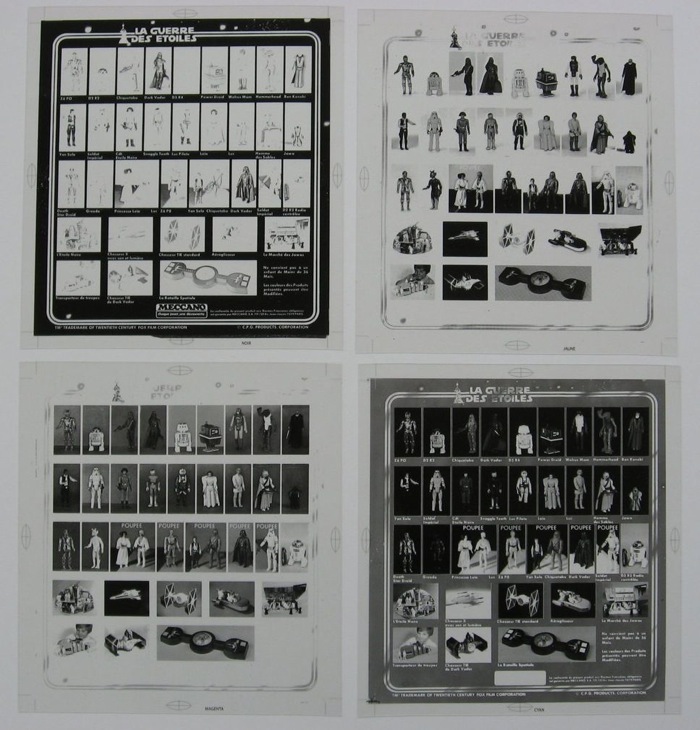


| Transparencies for Meccano square cardbacks | |
| Archive contributor Eric Thiele recently unearthed some black and white transparencies used to create the printing plates for the Meccano Star Wars 20-backs cards. Along with Archive contributor Stephane Faucourt, they then used these to create new color transparencies and cromalins (see below), thereby recreating a few steps in the vintage design process. Stephane Faucourt also did some research into this process, and he's been kind enough to share his discoveries in the paragraphs below.
The color transparencies were reproduced by placing each of the original film in a modern photocopier and selecting the output with the correct CMYK color;
We found these items so interesting that we wanted to gather more information about the design process used to produce these cardbacks. The research led me to someone working in the printing/marketing industry in the 1970s, who clarified for me the process used to create toy packaging at that time.
The first thing in the process was to design a mock-up, usually in black and white. Then, each item featured on the cardback had to be shot individually.
On this particular item, action figures were photographed in rows. You can get an idea of this by looking at shots of the figures drawn from Meccano's catalog, which show the figures in their original rows.
These shots were then 'converted' into individual transparencies. It was a very expensive process, but it allowed the photos to be re-used in a multitude of formats (i.e. catalogs, other toy packages). As a comparison ROTJ cardbacks were much less expensive to design as they used a single picture on the back. These elements (mock-up + transparencies) were then given to a photoengraver. A picture of the background and text only was taken - in this particular item, the background would have been a full picture of the black background with star field, silver bars and logo. Cyan, black, magenta and yellow transparencies were then put into a rotative-scanner. They were basically placed around a transparent glass tube, which rotated into a complex lens mechanism. Rotative scanners are still being used nowadays by some graphic compagnies working for marketing/press industry. The rotating scanner allows several things, but most importantly it produces a positive film of each printing color and reduces (or enlarge) the printing size of the film by playing on DPI (dots per inch) resolution. Then for EACH printing color, all the elements were hand assembled onto a special tool which allowed a very precise placement using rulers. Once assembled, the whole thing was shot to make the film for the associated color. In the case of this cardback, there are many pictures of individual items and these items are very close to each other, so it was not possible to manually assemble them at one time (there were no computers or Photoshop to do that). A mask was created using a red 2-layered transparent sheet material called "rubilite", so in fact each color was shot at least twice, giving a result of TWO transparencies for each key color. Finally, a "dither", with a different angle for each color, was applied on each film in order to insure that each color had the correct printing pattern (process still used nowadays). Then all the elements were combined for a final shot using a special camera to create the film used for printing. The film was probably copied several times and then used to UV engrave the printing plate for each color. It's also important to note that all the creation design in France was done in positive, while americans were working in negative. Apart from being more expensive, working with individual pictures allowed to make changes easily on the cardback by replacing items or changing colors, as done on later Meccano square card backs. For example, changing the Meccano logo to red (2nd wave Meccano 20-back card) was done by placing a Meccano logo on another key color; Changing the vehicles and figures (ESB cardback) just needed to redo the entire process using the same material but updating only the needed individual frames. If you look at the pictures of the transparencies I've redone in color and also the cromalin, you'll notice the incredible details compared to the original cardback which is printed on a matte cardboard. It's even possible to see that Luke X-Wing's gun is upside down, which is far less obvious on the original cardback. |
| Description by: | Ron Salvatore, Stephane Faucourt |
| Photo: | Stephane Faucourt |
| From the collection of: | Eric Thiele |
| Country: | France |
| Film: | A New Hope |
| Licensee: | Meccano |
| Year: | 1978 |
| Category: | Prototypes / Prototype Packaging and Proofs |